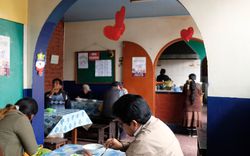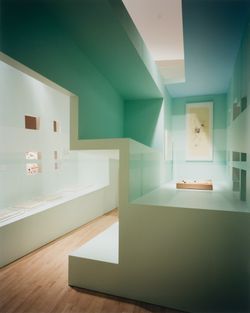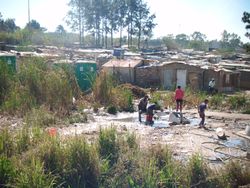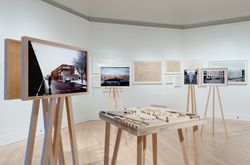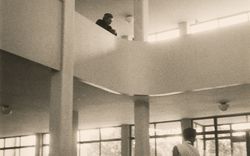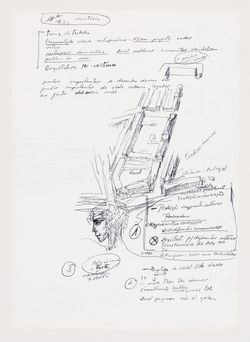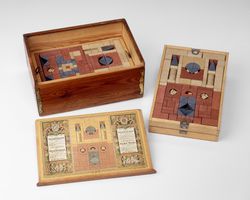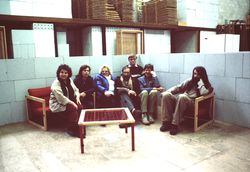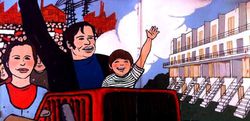articles
Shared Worlds
A Social Reset
Shared housing, co-living, new society, Rodrigo Kommers Wender, PLOT, Catching Up With Life
14 March 2021
A Social Reset
*Cities of Artificial Excavation: The Work of Peter Eisenman, 1978–1988* explores how American architect and writer Peter Eisenman questioned the concept of “site,” and demonstrates the importance of drawing and modelmaking in generating his ideas. The exhibition reveals the richness and complexity of the design process by looking carefully at Eisenman’s drawings and(...)
Main galleries
2 March 1994 to 19 June 1994
Cities of Artificial Excavation: The Work of Peter Eisenman, 1978-1988
Actions:
Description:
*Cities of Artificial Excavation: The Work of Peter Eisenman, 1978–1988* explores how American architect and writer Peter Eisenman questioned the concept of “site,” and demonstrates the importance of drawing and modelmaking in generating his ideas. The exhibition reveals the richness and complexity of the design process by looking carefully at Eisenman’s drawings and(...)
Main galleries
2016 Visiting Scholar Olumuyiwa Adegun presents his research: European cities of the nineteenth century, like African cities today, experienced severe housing problems. Shanty towns marked Berlin and Paris in ways that are similar to how Nairobi and Johannesburg have been characterized by informal settlements in the last few decades. This lecture explores the history of(...)
Shaughnessy House
4 August 2016, 6pm
Visiting Scholar Seminar: Olumuyiwa Adegun
Actions:
Description:
2016 Visiting Scholar Olumuyiwa Adegun presents his research: European cities of the nineteenth century, like African cities today, experienced severe housing problems. Shanty towns marked Berlin and Paris in ways that are similar to how Nairobi and Johannesburg have been characterized by informal settlements in the last few decades. This lecture explores the history of(...)
Shaughnessy House
Wohnhaus Schlesisches Tor—also known as Bonjour Tristesse—in Berlin and Punt en Komma in The Hague are Álvaro Siza’s first built works outside his native Portugal. The two projects resemble one another in size, scale, program, and ambition: both were built in the 1980s, both are results of a distinct attitude towards the city, and both were social housing projects(...)
Octagonal gallery Keyword(s):
Álvaro Siza, Punt en Komma, The Hague, Bonjour Tristesse, Berlin
24 September 2015 to 22 May 2016
Corner, Block, Neighbourhood, Cities. Álvaro Siza in Berlin and The Hague
Actions:
Description:
Wohnhaus Schlesisches Tor—also known as Bonjour Tristesse—in Berlin and Punt en Komma in The Hague are Álvaro Siza’s first built works outside his native Portugal. The two projects resemble one another in size, scale, program, and ambition: both were built in the 1980s, both are results of a distinct attitude towards the city, and both were social housing projects(...)
Octagonal gallery Keyword(s):
Álvaro Siza, Punt en Komma, The Hague, Bonjour Tristesse, Berlin
articles
Ideas of living
16 August 2018, 6:30pm
Study Room Keyword(s):
visiting scholars 2018, Hans-Georg von Arburg. German housing, toys
9 August 2018, 6:30pm
Study Room Keyword(s):
visiting scholars 2018, Hans-Georg von Arburg. German housing, toys
Following an intense period of work in the mid-1970s with Portugal’s post-revolutionary housing initiatives, in the early 1980s Álvaro Siza contributed projects to two of the most important urban renewal programs in Europe: Berlin’s IBA and The Hague’s Stadsvernieuwing als Kulturel Aktiviteit (Urban Renewal as a Cultural Activity). This lecture will examine the(...)
26 November 2015
Álvaro Siza’s Archaeology of the Ordinary
Actions:
Description:
Following an intense period of work in the mid-1970s with Portugal’s post-revolutionary housing initiatives, in the early 1980s Álvaro Siza contributed projects to two of the most important urban renewal programs in Europe: Berlin’s IBA and The Hague’s Stadsvernieuwing als Kulturel Aktiviteit (Urban Renewal as a Cultural Activity). This lecture will examine the(...)
Series
Projets et réalisations
AP066.S2
Description:
Issue de la pratique professionnelle de Jacques Rousseau, cette série regroupe les documents illustrant quatre-vingt-trois projets et réalisations conçus, soit de façon autonome ou en collaboration, entre 1973 et 1997. Ces projets se distinguent autant par leur degré d'achèvement (de l'esquisse préliminaire au dessin de construction), par leur échelle (du mobilier au projet urbain), que par leur programme (commercial, domestique, social). Dans l'ensemble, tous les thèmes qui sont explorés, tels l'architecture du bar, le décor de la boutique, l'habitation individuelle et collective, le lieu de travail, et l'image publique des institutions, s'ancrent dans une pensée spéculative sur la ville comme processus de reconstruction et de refondation. Parmi les quatre-vingt-trois projets, vingt datent d'avant 1980, date à laquelle Jacques Rousseau est devenu membre de l'Ordre des architectes du Québec. Ces projets ont donc été réalisés soit pour le compte d'agences pour lesquelles Jacques Rousseau travaillait ou effectuait son stage professionnel, soit à titre officieux en offrant vraisemblablement ses services à ses connaissances. Dans ce dernier cas, il s'agit alors de projets de plus petite envergure pour des rénovations ou agrandissements de résidences. Par ailleurs, un certain nombre de nouveaux projets n'ont pas abouti et sont constitués seulement de dossiers préliminaires qui nous renseignent toutefois sur les démarches entreprises par l'architecte, parfois de sa propre initiative, pour amorcer des projets. La variété de ces derniers montre les multiples intérêts de Jacques Rousseau. Toutefois, trois d'entre eux émergent de sa pratique : l'architecture de bar et de restaurant, le logement collectif coopératif et la morphologie urbaine pour lesquels il consacre de nombreux projets et études. On trouvera aussi d'ailleurs dans la série 9 - Enseignement des documents relatifs à ses travaux sur la morphologie urbaine.
1973-1997
Projets et réalisations
Actions:
AP066.S2
Description:
Issue de la pratique professionnelle de Jacques Rousseau, cette série regroupe les documents illustrant quatre-vingt-trois projets et réalisations conçus, soit de façon autonome ou en collaboration, entre 1973 et 1997. Ces projets se distinguent autant par leur degré d'achèvement (de l'esquisse préliminaire au dessin de construction), par leur échelle (du mobilier au projet urbain), que par leur programme (commercial, domestique, social). Dans l'ensemble, tous les thèmes qui sont explorés, tels l'architecture du bar, le décor de la boutique, l'habitation individuelle et collective, le lieu de travail, et l'image publique des institutions, s'ancrent dans une pensée spéculative sur la ville comme processus de reconstruction et de refondation. Parmi les quatre-vingt-trois projets, vingt datent d'avant 1980, date à laquelle Jacques Rousseau est devenu membre de l'Ordre des architectes du Québec. Ces projets ont donc été réalisés soit pour le compte d'agences pour lesquelles Jacques Rousseau travaillait ou effectuait son stage professionnel, soit à titre officieux en offrant vraisemblablement ses services à ses connaissances. Dans ce dernier cas, il s'agit alors de projets de plus petite envergure pour des rénovations ou agrandissements de résidences. Par ailleurs, un certain nombre de nouveaux projets n'ont pas abouti et sont constitués seulement de dossiers préliminaires qui nous renseignent toutefois sur les démarches entreprises par l'architecte, parfois de sa propre initiative, pour amorcer des projets. La variété de ces derniers montre les multiples intérêts de Jacques Rousseau. Toutefois, trois d'entre eux émergent de sa pratique : l'architecture de bar et de restaurant, le logement collectif coopératif et la morphologie urbaine pour lesquels il consacre de nombreux projets et études. On trouvera aussi d'ailleurs dans la série 9 - Enseignement des documents relatifs à ses travaux sur la morphologie urbaine.
Series
1973-1997
Evoking a provocation famously framed by Le Corbusier, “Architecture ou Révolution,” this conversation will situate the SAAL process in Portugal within international debates during the 1960s and 1970s on social housing and the architect’s social responsibility. Nuno Portas, Secretary of State for Housing and Urbanism of the government established after the 1974 Portuguese(...)
Paul-Desmarais Theatre
14 May 2015 , 6pm
Architecture or Revolution? A Conversation with Nuno Portas and Nuno Grande
Actions:
Description:
Evoking a provocation famously framed by Le Corbusier, “Architecture ou Révolution,” this conversation will situate the SAAL process in Portugal within international debates during the 1960s and 1970s on social housing and the architect’s social responsibility. Nuno Portas, Secretary of State for Housing and Urbanism of the government established after the 1974 Portuguese(...)
Paul-Desmarais Theatre
